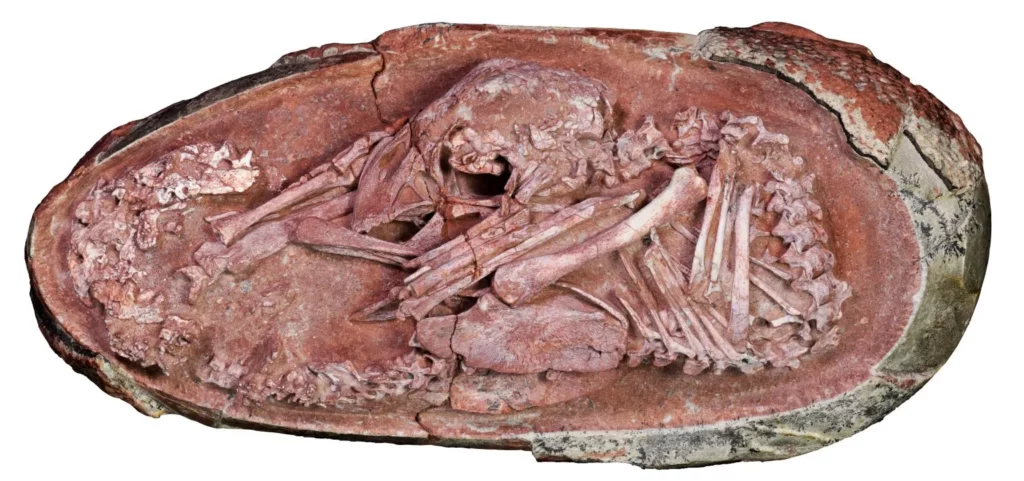While dinosaurs haven’t roamed the Earth for hundreds of millions of years, scientists still spend a great amount of time researching and understanding these mythical creatures and how they impact species today.
Even today, scientists are still discovering fossils and learning more about prehistoric creatures. Their relation to modern-day species can help us understand the origins of our species.
Most recently, scientists uncovered a perfectly-intact dinosaur embryo. Its discovery has answered questions for scientists about how dinosaurs were hatched and the evolutionary adaptions that appear in modern-day birds.

Discovering Baby Yingliang
Over the last 100 years, scientists have discovered several fossilized dinosaur eggs and nests, which have helped to connect the dots between dinosaurs and modern-day birds.
However, it’s been extremely rare to discover a well-preserved and intact dinosaur embryo, as the bones are easily broken or shifted around — That is until scientists revisited a box of fossils that had been forgotten about.
In the Jiangxi Provence of Southern China, Liang Liu, the director of Yingliang Group, acquired a set of suspected dinosaur egg fossils in 2000.
The collection of fossils sat in storage until 2010 when, during the construction of the Yingliang Stone Nature History Museum, staff sorted through the storage and discovered the fossils that had been forgotten about.
The staff discovered a box of dinosaur eggs and noticed some of them had a broken egg section. Upon closer look, scientists discovered a perfectly intact oviraptorosaur dinosaur embryo curled up within the eggs.
The embryo, expected to be between 72 and 66 million years old, was named Baby Yingliang and showed a curled-up embryo reminiscent of modern-day birds. Only six by three inches, the egg shows the baby oviraptorosaur’s skeleton perfectly preserved in its original anatomical composition.
“This dinosaur embryo inside its egg is one of the most beautiful fossils I have ever seen. This little prenatal dinosaur looks just like a baby bird curled in its egg, which is yet more evidence that many features characteristic of today’s birds first evolved in their dinosaur ancestors,” said Professor Steve Brusatte, a researcher from the University of Edinburgh who was on the Baby Yingliang research team.
As a late-stage embryo, the skeleton measures about 9 inches and fills most of the egg’s space. Scientists believe it was close to hatching when it was buried rapidly by mud or sand, keeping it safe from any predators or other natural events.
Oviraptosaurs are toothless, four-legged dinosaurs that lived in Asia during the Late Cretaceous period. They were smaller, omnivorous dinosaurs that were known for originally known for eating eggs and had large beaks to accommodate breaking eggs.
Adults ranged from about three feet tall to six feet tall and had long talons in exchange for their lack of teeth. Without teeth, their long legs were expected to be their main defense.
A startling connection to modern-day birds
The discovery of Baby Yingliang illustrated how similar these creatures were to that of birds today. The embryo showed how dinosaurs also developed a “tucked” posture before hatching, identical to that of two-legged bids.
This tucked position results from the central nervous system, which is critical to the animal hatching successfully. Embryos that do not get into this tucked position have a less likely chance of surviving the hatching process.
Originally considered unique to birds, this position would indicate that the pre-hatching behavior shown in the fossil of Baby Yingliang was a broader behavior across species. Fion Waisum Ma, a researcher at the University of Birmingham who examined Baby Yingliang, said the discovery of the embryo “answers a lot of questions about dinosaur growth and reproduction.”
“It is interesting to see this dinosaur embryo and a chicken embryo pose similarly inside the egg, which possibly indicates similar prehatching behaviors,” Waisum Ma said. “We were surprised to see this embryo beautifully preserved inside a dinosaur egg, lying in a bird-like posture. This posture had not been recognized in non-avian dinosaurs before.”
The Origin of Birds
With Baby Yiangliang’s age dating back hundreds of million years ago, the discovery opens the door to understanding more clearly how the hatching process has evolved across different species.
Since there are so few embryos intact the way Baby Yiangliang’s is, there is limited understanding of how dinosaurs were birthed or formed before hatching.
However, it’s long been established that birds evolved from a type of Mesozoic dinosaur. Dozens of fossils of these four-legged theropod dinosaurs have resulted in present-day scientists mostly agreeing that this is the origin of birds.
There are disagreements over the specific evolutionary process that resulted in the featured and winged birds we know today. Still, the discovery of Baby Yingliang is one additional piece to confirm the origin story presented by scientists.
While it’s well-known that Charles Darwin was one of the first to examine the origin of birds, other scientists in the 19th and 20th Centuries followed suit. In the 1870s, the iconic Archaeopteryx was discovered, showing the first evolutionary link between birds and reptiles.
This fossil, complete with reptilian teeth and wings, led more researchers like Edward Drinker Cope and Thomas Henry Huxley to draw additional similarities between dinosaurs and birds.
In Baby Yingliang’s backyard, additional preserved bird fossils in China showed long filamentous structures identified as “advanced” feathers. While it’s unlikely these birds flew, their feathers could have served various purposes like protection, attracting mates, or increasing functionality in the water.
—
In the scientific paper outlining the historical discovery, researchers say they will continue to study the specimen using imaging techniques to examine further Baby Yiangliang’s skull, bones, and other anatomical parts still covered by rock.
As technology advances and scientists uncover more fossilized embryo’s out there, our understanding of the connection between other prehistoric creatures’ and our modern-day species becomes clear. Baby Yingliang’s discovery is another piece of the puzzle to our prehistoric past.

